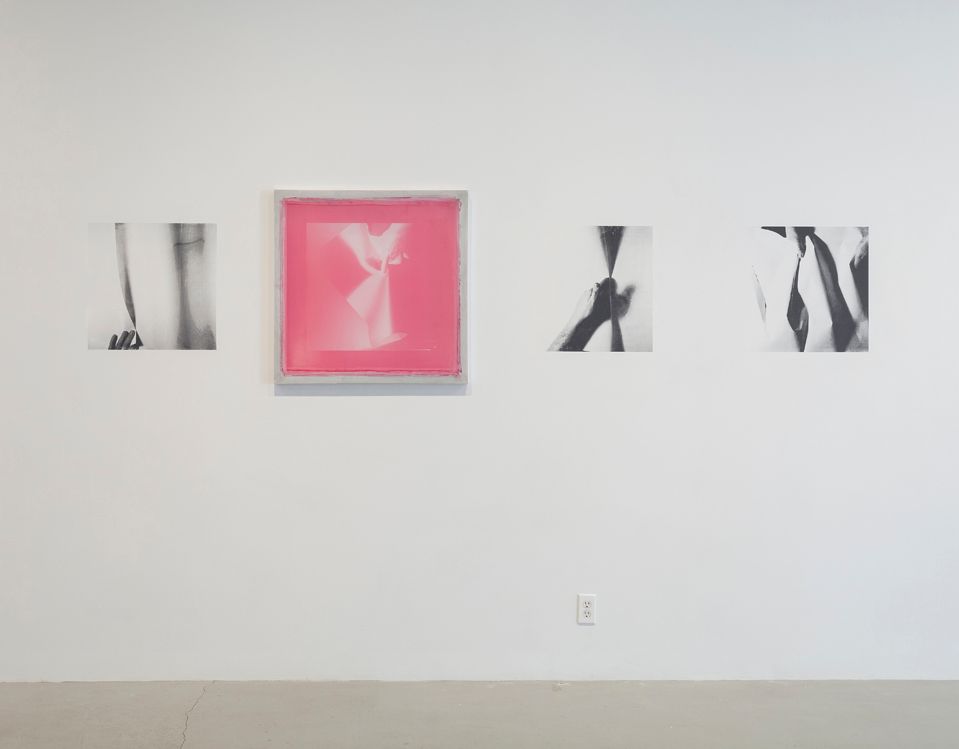Julien Bismuth’s latest body of work ranges from video to silkscreens to audio pieces, and continues his inquiry into the mechanisms of communication. His practice reflects on the complex manner in which ideas are transmitted in artworks and subsequently in spoken or written language. For Bismuth, a work of art does not contain ideas. It does not even state them, at least not in the way of a sentence. What an artwork makes possible is the articulation an idea in language: it makes the viewer speak.
An image as the ______ of a surface is built upon a series of oppositions that show how the irreconcilability of two things is a source of profound meaning. This productive tension is at the heart of Bismuth’s Monologue for the lowest and highest points in the room, an audio piece based upon the perceived dichotomy between appropriation and originality. Read by an actress instructed to inflect her voice with apposite feeling, the work weaves together statements of intention from Bismuth as well as other artists, curators, CEO’s, pop stars, real estate developers, amongst others. This amalgamation of ambitions reflects upon what people strive for today, and the similarities between those in disparate fields is at once striking, humorous, and somewhat disquieting.
The play between poles in Monologue for the lowest and the highest points in the room is also apparent in two films on view: Reader and Perroquet (Parakeet). Reader shows Bismuth, back turned from the screen, absorbed in a book. Shot during sunset, varying light conditions suffuse the piece . Perroquet (Parakeet) is a close-up of a woman’s face as she watches the Wizard of Oz, a film saturated in color that projects ambient light on her countenance. Both pieces are about private experiences and the difficulty of sharing them. The wash of gentle colors in the films, shifting from one to the other like the alterations in a rainbow, are metaphors for the translation of private experiences to the world at large: a chance to offer semblances and approximations but never the thing itself.
The associative power of metaphors is a compelling feature of Bismuth’s work. Throughout the space are a series of silkscreens that reflect upon what it means to make an image. The silkscreens depict the manipulation of a sheet of white paper. The titles of the works—An image as the extension of a surface, An image as the insinuation of a surface, An image as the obstruction of a surface, for example—are metaphors that get tagged to the piece, some of which link directly, others less so. In the moving, folding, crumpling, casting a shadow on, or tearing a sheet of paper, Bismuth goes through a kind of shorthand of the sprawling vocabulary of gestures used for image making today. The visual is printed directly onto the gallery’s walls, the screens shown either alongside or in different parts of the space. It is the screens that are the works of art, not the prints, which are merely a byproduct of the representational act. Bismuth inverts traditional expectations for the medium as a way to allow for reproductions to occur with all their flaws and inconsistencies and, most importantly, without the fetishization of the authorial imprint.
Julien Bismuth (born 1973 in Paris) works and lives in New York. Solo exhibitions include shows at La Ferme Du Buisson, Marne-la-Vallée, France; the Gesellschaft für aktuelle Kunst Bremen, Germany; Emanuel Layr Galerie, Vienna, Austria; The Box, Los Angeles, CA; Crac Alsace, Altkirch, France; Bloomberg Space, London, England; Parisa Kind Galerie, Frankfurt, Germany and Galerie Georges-Philippe & Nathalie Vallois, Paris, France. Bismuth took part in numerous group shows, for example at the Palais de Tokyo, Paris, France; La Nuit Blanche, Paris, France; Musée du Jeu de Paume, Paris, France; Kunsthalle Wien, Vienna, Austria; ICA Philadelphia; 12e Prix Fondation d’entreprise Ricard, Paris, France; Schirn Kunsthalle, Frankfurt, Germany; Villa Arson, Nice, France; Musée du Jeu de Paume, Paris, France; Orange County Museum, Newport Beach, CA. His performances (often in collaboration) could be seen at such places as MUSAC, Leon, Spain; Tate Modern London, England; and Parasol Unit, London, England. In addition, Bismuth founded the publishing house Devonian Press with Jean-Pascal Flavien in 2005.



































































































